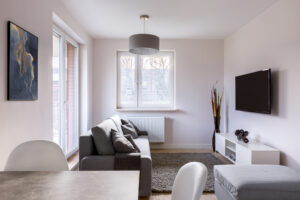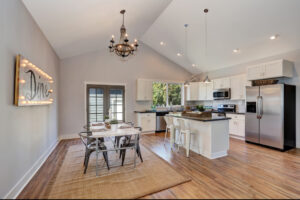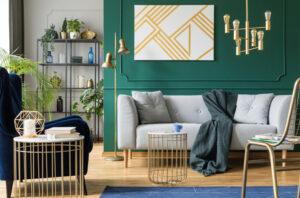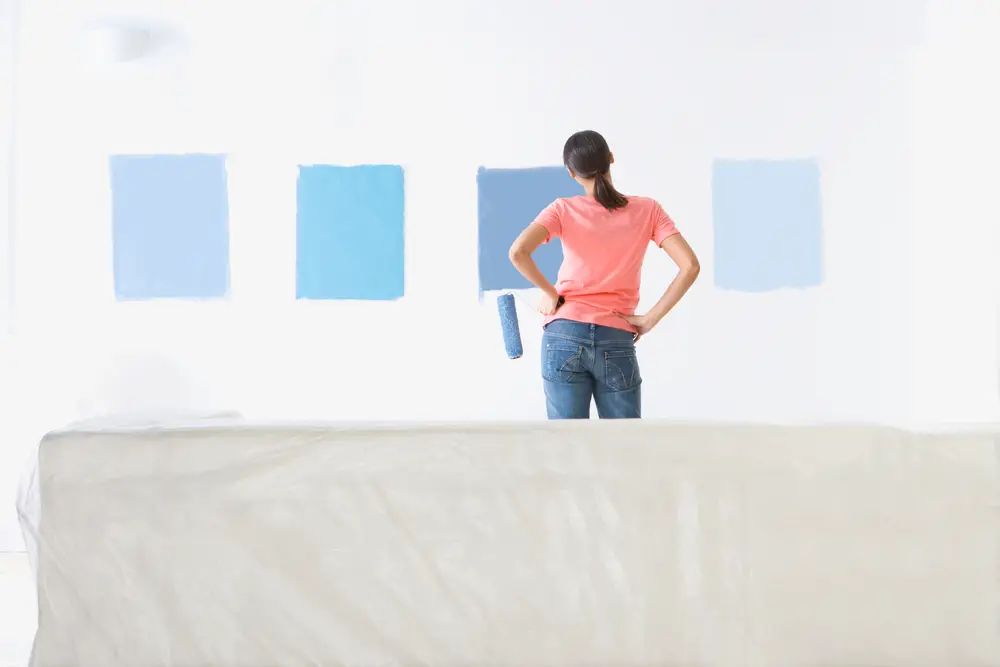
Choosing the right paint colour for each room can make a big difference in the overall look and feel of your home. It’s not just about finding a colour you like; it’s about choosing a colour that complements the space and creates the desired atmosphere. In this article, I’ll share some tips and recommendations to help you select the perfect paint colour for every room in your home.
Create a Colour Scheme That Matches Your Home’s Furniture
One effective way to choose the right paint colour for each room is to create a colour scheme that matches your home’s furniture. By selecting three colours from an existing object in your home, such as a pillow or a painting, you can create a cohesive and harmonious look. Take those colours to the paint store and find sample strips with those colours to explore a range of paint options. Choose one colour as the wall colour and save the other two for use around the room in fabrics or furnishings. For adjacent rooms, you can use the same three colours and select a fourth colour as an accent to create a connection between spaces.
Decide on the Finish to Create an Appealing Visual Effect
Once you’ve chosen your paint colours, it’s important to decide on the finish to create an appealing visual effect. The finish you choose can impact the overall look and feel of the room. A satin (or eggshell) finish is commonly used for walls because it is scrubbable and doesn’t draw attention to imperfections. Semi-gloss and high-gloss finishes are often used for trim to accentuate the curves of moldings or doors. However, finishes can also be used creatively to create visual effects on the entire wall. For example, painting one wall in a flat or satin finish and the adjacent wall in a semi-gloss finish in the same colour can create a textured effect when light hits the walls.
Match the Colour to the Feeling You Want in the Room
Colours evoke emotional responses, so it’s important to match the colour to the feeling you want in each room. Cool colours, such as blues, greens, and clean whites, are perceived as restful and soothing, making them suitable for private rooms like bedrooms and bathrooms. On the other hand, warm colours, like reds, oranges, and yellows, create a sense of drama and energy, making them ideal for social spaces like dining rooms and living areas. Remember that the psychology of colour is subjective, so consider your preferences and the mood you want to establish in each room.
Know Your Whites
Whites come in a variety of shades and undertones, so it’s important to know your whites when choosing paint colours. Pure whites are without tinted undertones and are often used to showcase artwork or furnishings. Warm whites have yellow, rust, pink, or brownish undertones, creating a cosy atmosphere or compensating for limited natural light. Cool whites have green, blue, or grey undertones and can help open up a space. Test several whites to see which one works best with the other colours in the room.
Key Takeaways:
- Choose a paint colour that complements the space and creates the desired atmosphere.
- Create a colour scheme that matches your home’s furniture to achieve a cohesive look.
- Select the right finish to enhance the visual effect of the room.
- Consider the emotional response and match the colour to the feeling you want in each room.
- Understand the different shades and undertones of whites when choosing paint colours.
Create a Colour Scheme That Matches Your Home’s Furniture
One way to choose the right paint colour for each room is to create a colour scheme that matches your home’s furniture. Start by selecting three colours from an existing object in your home, such as a pillow or a painting. Take those colours to the paint store and find sample strips with those colours, which will give you a range of paint options. Choose one colour as your wall colour and save the other two for use around the room in fabrics or furnishings. For adjacent rooms, you can use the same three colours to choose another colour. Finally, select a fourth colour that can be used as an accent in every room to create a connection between spaces.
Creating a colour scheme that matches your furniture helps to create a harmonious and cohesive look in your home. By pulling colours from your existing furnishings, you can ensure that your paint choices complement and enhance the overall aesthetic of each room. This approach also allows you to tie different spaces together by using the same colours across adjacent rooms.
An architectural colour consultant can also provide valuable guidance in choosing paint colours that harmonize with your furniture. These professionals have expertise in colour theory and can help you select the perfect shades and tones to create the desired atmosphere in your home.
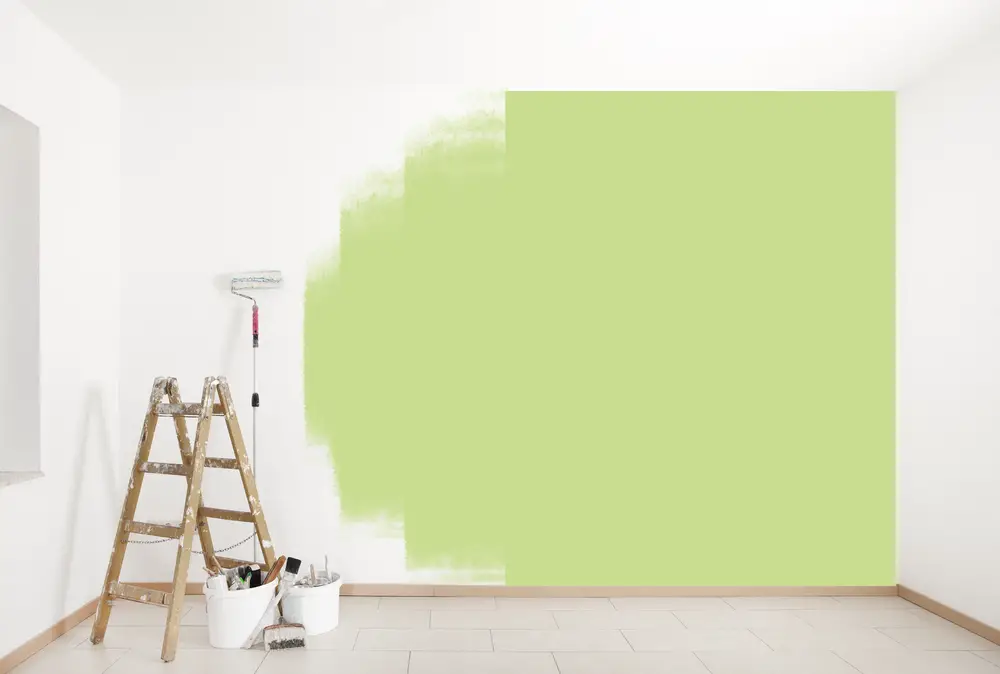
Benefits of Matching Furniture with Paint Colours
- Creates a cohesive and harmonious look in your home
- Enhances the aesthetic appeal of each room
- Ties different spaces together for a unified design
- Allows your furniture to stand out as focal points
- Provides a sense of balance and visual continuity
By taking the time to create a colour scheme that matches your home’s furniture, you can transform your space into a visually pleasing and inviting environment. Whether you’re redecorating a single room or the entire house, this approach will help you achieve a cohesive and stylish design that reflects your personal taste and showcases your furniture.
Decide on the Finish to Create an Appealing Visual Effect
Once you have chosen your paint colours, the next step is to decide on the finish to create an appealing visual effect. The right finish can enhance the overall look and feel of a room, adding depth and texture to the painted surfaces. Here are some popular finishes to consider:
Satin Finish
A satin finish, also known as an eggshell finish, is a versatile choice that is commonly used for walls. It provides a subtle sheen that adds depth to the colour while still maintaining a smooth and elegant appearance. Satin finishes are ideal for high-traffic areas as they are scrubbable and easy to clean. Additionally, they don’t draw attention to minor imperfections on the wall surface, making them a popular choice for most rooms in the house.
Semi-Gloss Finish
For trim and woodwork, a semi-gloss finish is often preferred. This finish has a higher sheen than satin and provides a durable and reflective surface. It accentuates the curves of moldings and doors, giving them a polished and sophisticated look. Semi-gloss finishes are also resistant to moisture and can withstand frequent cleaning, making them suitable for areas prone to splashes and stains.
Glossy Finish
If you want to make a bold statement or create a striking visual effect, a glossy finish might be the right choice. This high-sheen finish reflects light and adds a dramatic touch to any room. While it is less commonly used on walls, it can be applied to create accent walls or highlight architectural features. The glossy finish adds a sense of glamour and creates a luxurious atmosphere in the space.
Remember, finishes can also be used creatively to play with visual effects. For example, you can experiment with combining different finishes on adjacent walls to create a textured effect when light hits the surfaces. One wall painted in a flat or satin finish and the adjacent wall in a semi-gloss finish in the same colour can create an interesting contrast and add depth to the room.
Match the Color to the Feeling You Want in the Room
Colours have the power to evoke emotional responses and set the mood in a room. When choosing the right paint colour, it’s important to consider the feeling you want to create in each space. Understanding colour psychology can help you make informed decisions and create a harmonious atmosphere.
Cool colours, such as blues, greens, and clean whites, are known to be restful and soothing. They can create a sense of calmness and tranquillity, making them ideal for private rooms like bedrooms and bathrooms. These colours are often associated with nature and can promote a peaceful ambience in your personal spaces.
On the other hand, warm colours like reds, oranges, and yellows can bring a sense of drama and energy to a room. They are vibrant and stimulating, making them well-suited for social areas like dining rooms and living spaces. Warm colours can create an inviting and lively atmosphere, encouraging conversation and interaction among guests.
It’s important to note that colour psychology is subjective, and individual preferences play a significant role. While certain colours may generally evoke specific emotions, personal associations and cultural influences can impact how colours are perceived. Consider your own preferences and the desired mood for each room when selecting paint colours.
Some tips for selecting colours based on emotional response:
- For a calming and serene atmosphere, choose cool colours like soft blues, greens, or whites.
- To create an energetic and vibrant space, opt for warm colours such as reds, oranges, or yellows.
- Combine warm and cool colours to create a balanced and harmonious environment.
- Consider the function of the room when selecting colours. For example, a home office may benefit from a cool and focused colour palette, while a dining room may benefit from warm and stimulating tones.
Remember that the colour of a room can greatly influence the overall ambience and affect how people feel in that space. By selecting colours that align with the desired feeling and considering the principles of colour psychology, you can create rooms that are not only aesthetically pleasing but also emotionally engaging.
Know Your Whites
When it comes to choosing the perfect paint colour for your space, it’s important to know your whites. Whites may seem simple, but they come in a variety of shades and undertones that can significantly impact the overall look and feel of a room.
Pure Whites
Pure whites are the classic choice, without any tinted undertones. They provide a clean and crisp appearance, making them ideal for showcasing artwork or furnishings. Pure whites can create a timeless and elegant atmosphere in any room.
Warm Whites
For rooms with limited natural light or to create a cosy and inviting atmosphere, warm whites are the way to go. With yellow, rust, pink, or brownish undertones, warm whites add a sense of warmth and comfort to any space. These tones can make a room feel more intimate and welcoming.
Cool Whites
If you’re looking to open up a space or create a fresh and airy feel, cool whites are the perfect choice. Cool whites have green, blue, or grey undertones that can make a room feel more spacious and bright. These shades are versatile and can work well in both modern and traditional interiors.
When selecting a white shade, it’s important to test several options to see how they interact with the other colours in the room. Natural and artificial lighting can also impact how a white shade appears, so it’s essential to consider these factors when making your final decision.
| Whites | Undertones | Best Use |
|---|---|---|
| Pure Whites | No tinted undertones | Showcasing artwork or furnishings |
| Warm Whites | Yellow, rust, pink, or brownish undertones | Rooms with limited natural light or to create a cozy atmosphere |
| Cool Whites | Rooms with limited natural light or to create a cosy atmosphere | Opening up a space or creating a fresh and airy feel |
Conclusion
Choosing the right paint colour for each room in your home is crucial for creating a cohesive and visually appealing design. By following these paint colour tips and room-specific suggestions, you can transform your rooms into inviting and stylish spaces that reflect your unique taste and personality.
To begin, create a colour scheme that matches your home’s furniture. This will ensure that the paint colours harmonize with your existing decor. Consider using a combination of three colours from an object in your home, such as a pillow or a painting, and use those colours as a starting point for your paint choices.
Next, decide on the finish to create the desired visual effect. Different finishes, such as satin, semi-gloss, and high-gloss, can be used strategically to accentuate architectural features or create texture on the walls. Carefully consider the finish for each room to achieve the desired aesthetic.
Lastly, match the colour to the feeling you want to evoke in each room. Cool colours like blues and greens can create a restful and soothing atmosphere, perfect for bedrooms and bathrooms. Warm colours like reds and oranges can add a sense of drama and energy, making them ideal for social spaces like dining rooms and living areas. Take into account the psychology of colour and the mood you want to establish.
By incorporating these paint colour tips and room-specific suggestions, you can create a cohesive home design that reflects your personal style and enhances the overall look and feel of your space. Remember to consider your personal preferences and the overall design style of your home. With a little planning and creativity, you can transform your home with the perfect paint colours.
FAQ
How can I choose the right paint color for each room?
One way to choose the right paint color for each room is to create a color scheme that matches your home’s furniture. Start by selecting three colors from an existing object in your home, such as a pillow or a painting. Take those colors to the paint store and find sample strips with those colors, which will give you a range of paint options. Choose one color as your wall color and save the other two for use around the room in fabrics or furnishings. For adjacent rooms, you can use the same three colors to choose another color. Finally, select a fourth color that can be used as an accent in every room to create a connection between spaces.
What finish should I use for my walls and trim?
The finish you choose for your walls and trim depends on the effect you want to create. A satin (or eggshell) finish is commonly used for walls because it is scrubbable and doesn’t draw attention to imperfections. Semi-gloss and high-gloss finishes are often used for trim to accentuate the curves of moldings or the panels of doors. However, finishes can also be used creatively to create visual effects on the entire wall. For example, painting one wall in a flat or satin finish and the adjacent wall in a semi-gloss finish in the same color can create a textured effect when light hits the walls.
How do colors affect the mood of a room?
Colors evoke emotional responses, and it is important to match the color to the feeling you want in each room. Cool colors such as blues, greens, and clean whites are perceived as restful and soothing, making them suitable for private rooms like bedrooms and bathrooms. Warm colors like reds, oranges, and yellows create a sense of drama and energy, making them ideal for social spaces like dining rooms and living areas. The psychology of color is subjective, so it is important to consider your own preferences and the mood you want to establish in each room.
What should I know about using white paint?
Whites come in a variety of shades and undertones. Pure whites are without tinted undertones and are often used to showcase artwork or furnishings. Warm whites have yellow, rust, pink, or brownish undertones, and are suitable for rooms with limited natural light or to create a cozy atmosphere. Cool whites have green, blue, or gray undertones, and can help open up a space. It is important to test several whites to see which one works best with the other colors in the room.
How can I create a cohesive home design with paint colors?
Choosing the right paint color for each room in your home is essential for creating a cohesive and visually appealing design. By creating a color scheme that matches your home’s furniture, deciding on the finish, matching the color to the desired feeling, and considering the light and size of each room, you can find the perfect paint color for every space. Remember to take into account your personal preferences and the overall design style of your home. With these tips and suggestions, you can transform your rooms into inviting and stylish spaces that reflect your unique taste and personality.
- Drill Battery Maintenance: Essential Tips for Cordless Drill Battery Care - February 5, 2024
- Troubleshooting Drill Issues - February 5, 2024
- Quick Drilling Techniques - February 2, 2024

